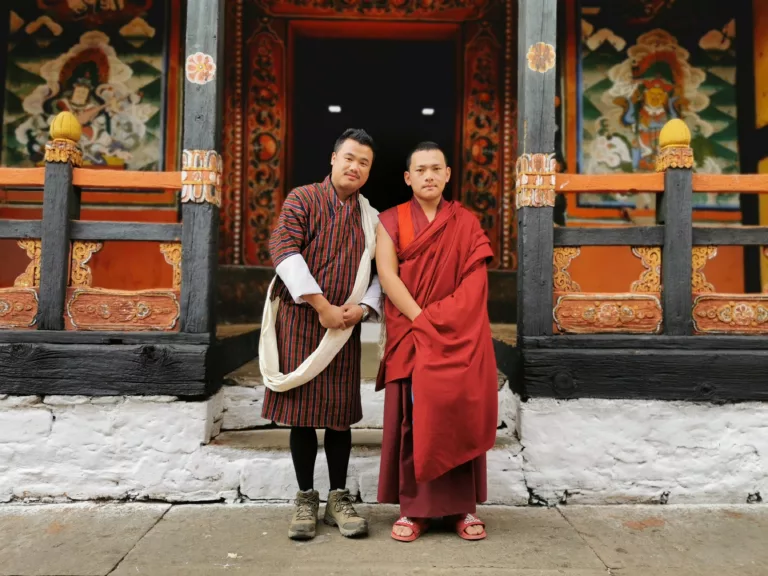Published on: January 27th, 2023, by Aue Therchen
Bhutan is a small, landlocked country located in the eastern Himalayas, bordered by China to the north and India to the south, east, and west. Known for its beautiful natural landscapes, rich cultural traditions, and commitment to environmental sustainability, Bhutan is a unique and captivating destination that attracts travelers worldwide.
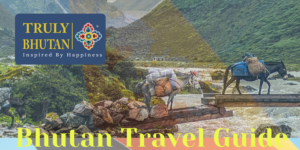
If you’re planning a trip to Bhutan, here’s everything you need to know to make the most of your journey:
Getting to Bhutan
There are a few different options for getting to Bhutan, depending on where you’re coming from. The most common entry point is through Paro which can be reached by plane.
Flying to Bhutan
The main international airport in Bhutan is Paro Airport, which is located about an hour’s drive from Thimphu. There are direct flights to Paro from several cities like New Delhi, Kolkata, Guwahati, Bagdogra, Kathmandu, Bangkok, Singapore, & Dhaka
Entering Bhutan by Road
If you’re coming from India, you can also enter Bhutan by road through one of several border crossings. The most popular route is from Siliguri in West Bengal, which is well-connected by train and bus to other major cities in India. From Siliguri, you can take a shared taxi or private vehicle to the border crossing at Phuentsholing, which is about four hours’ drive away. From there, it’s another five hours by road to Thimphu.
Sustainable Development Fee, Visa Fee, & Entry Requirements
All visitors to Bhutan must have a valid visa and travel with a licensed Bhutanese tour operator or through a Hotel. It is also a must to have a licensed Tour guide. One-time Bhutan Visas can be obtained through the Truly Bhutan website or directly through the Bhutanese embassy or consulate in your home country.
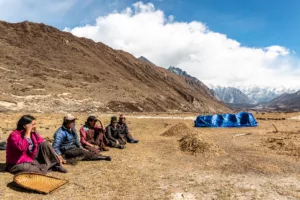
All Travelers Must also have to pay a Sustainable Development Fee(SDF) of USD 200 per person per night implemented and enforced from 20th June 2022.
To apply for a visa, you’ll need to provide the following documents:
- A valid passport with at least six months of validity remaining
- A completed visa application form
- Two passport-sized photographs
- A copy of your flight or bus ticket (if applicable)
Visa Fee is a one-time payment of US$ 40 per person and for Indians, there is no Visa Fee.
The Sustainable Development Fee (SDF)is US$200 per person per night and for Indians its Rs 1200 per person per night.
When to Visit Bhutan?
Bhutan has a varied climate, with temperatures ranging from warm and humid in the south to cold and dry in the north. The best time to visit Bhutan depends on the type of experience you’re looking for.
Spring (March to May)
Spring is a great time to visit Bhutan, as the weather is pleasant and the landscape is adorned with blooming flowers. This is also the time of year when the annual Paro Tshechu festival takes place, which is a major cultural event that attracts visitors from around the world.
Summer (June to September)
Summer is the monsoon season in Bhutan, with heavy rainfall and high humidity. While this isn’t the best time to visit if you’re planning to do a lot of outdoor activities, it can be an excellent time to visit if you’re looking for a more relaxed, low-key trip.
Autumn (October to November)
Autumn is a popular time to visit Bhutan, as the weather is cool and dry and the skies are typically clear. This is a good time for outdoor activities, such as hiking and sightseeing.
Winter (December to February)
Winter is Bhutan’s coldest time of year, with temperatures dropping below freezing in the higher altitudes. However, this can also be a beautiful time to visit, as the landscape is often blanketed in snow and the skies are clear, offering excellent views of the Himalayas.
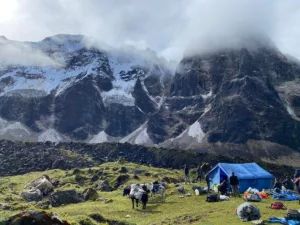
Getting Around Bhutan
Bhutan has a well-developed network of roads, and getting around the country by car is a popular option. You can either hire a private vehicle with a driver or join a group tour, which will typically include transportation.
If you prefer to explore on your own, you can also get around Bhutan by bus. The Bhutanese government operates a network of buses that connect major cities and towns throughout the country. Buses are typically crowded and uncomfortable, but they are an affordable way to get around.
Accommodation in Bhutan
Bhutan has a range of accommodation options to suit different budgets and preferences. The most popular options include hotels, guesthouses, and homestays. Hotels in Bhutan range from luxury resorts to more budget-friendly options with 3 stars. Many hotels in Bhutan offer traditional Bhutanese architecture and decor, as well as modern amenities such as en-suite bathrooms and Wi-Fi.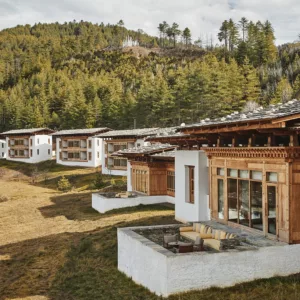
Guesthouses in Bhutan are typically small, family-run establishments that offer basic amenities such as private rooms with shared bathrooms. They are a good option for budget travelers looking for a more authentic experience. Homestays in Bhutan involve staying with a local Bhutanese family in their home. This is a great way to immerse you in Bhutanese culture and get to know the local way of life.
Food & Drink in Bhutan
Bhutanese cuisine is influenced by Tibetan and Indian flavors and features a variety of dishes made with rice, wheat, and maize. The national dish of Bhutan is ema datshi, which is made with chili peppers and cheese. Other popular dishes include momos (Tibetan dumplings), Jasha maru (spicy chicken), and Phaksha Laphu (Pork with Radish).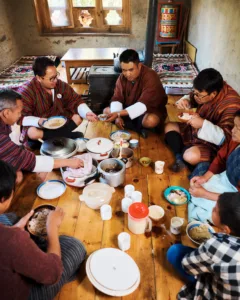
Bhutan is also known for its production of red rice and Buckwheat, which are used in a variety of dishes, including bread, noodles, and porridge. In Bhutan, it is traditional to eat with your hands, using a small ball of rice as a utensil to scoop up the curry. It is also customary to offer food to the gods before eating.
Bhutan is home to several indigenous fruit and vegetable varieties, including apples, bananas, oranges, pears persimmon, potatoes, radishes turnips, and tomatoes. The country is also known for its production of chili peppers, which are used in many Bhutanese dishes to add flavor and heat. When it comes to drinks, Bhutan is famous for its production of high-quality teas. The country is also home to a number of breweries that produce beer and whiskey brands.
Cultural Attractions in Bhutan
Bhutan is a country with a rich cultural heritage, and there are many cultural attractions to explore during your visit.
One of the most popular cultural attractions in Bhutan is the Tashichho Dzong, a fortress in Thimphu that serves as the seat of the Bhutanese government. The dzong is a beautiful example of Bhutanese architecture and is home to several important Buddhist temples. 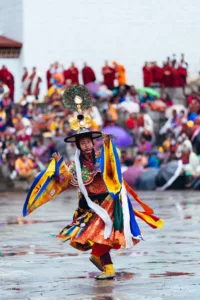
Another cultural attraction worth visiting is the Punakha Dzong, a fortress located in the Punakha Valley. The Dzong is home to several important Buddhist temples and is a popular site for religious festivals such as the Punakha Tshechu, which is held every year in February. The festival features traditional Bhutanese dances and rituals, as well as the unfurling of a giant Thongdrel (Buddhist appliqué embroidery and painting) and the reenactment of a historical battle.
Other cultural attractions in Bhutan include the National Museum of Bhutan, which showcases the country’s rich cultural, and natural history, and the Institute of Zorig Chusum, a school that teaches Thirteen traditional Bhutanese arts and crafts such as painting, woodcarving, and textile weaving.
Outdoor Activities in Bhutan
Bhutan is a paradise for outdoor enthusiasts, with a wide range of activities to enjoy, including trekking, rafting, and paragliding.
One of the most popular trekking routes in Bhutan is the Snowman Trek, which takes you through some of the highest and most remote regions of the country. The trek is considered one of the most challenging in the world, with passes reaching elevations of over 5,000 meters (16,400 feet).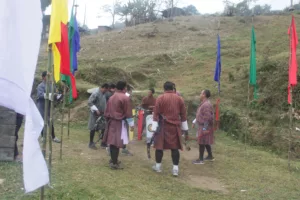
If you prefer water-based activities, Bhutan is home to several rivers that are ideal for rafting and kayaking. The Mo Chu and Po Chu rivers are popular options, with rapids ranging from class II to class IV.
Paragliding is another popular outdoor activity in Bhutan, with several companies offering tandem flights and lessons. The Paro Valley is a particularly good spot for paragliding, with its stunning mountain views and clear skies.
Environmental Sustainability in Bhutan
One of the things that set Bhutan apart from other countries is its commitment to environmental sustainability. The Bhutanese government has made it a priority to protect the country’s natural environment, and Bhutan is the only country in the world to have a policy of zero net greenhouse gas emissions. The constitution requires a minimum of 60% of the country’s forest reserve to be maintained for all time to come.
One of the ways Bhutan has achieved this goal is through the use of hydroelectric power, which accounts for the majority of the country’s electricity needs. Bhutan is also home to a number of protected areas, including national parks and wildlife sanctuaries, which help to preserve the country’s unique biodiversity.
Final Thoughts
Bhutan is a unique and fascinating destination that offers something for everyone. Whether you’re interested in exploring the country’s rich cultural heritage, enjoying outdoor adventures, or learning about Bhutan’s commitment to environmental sustainability, there’s something for you in Bhutan. With its stunning natural landscapes, friendly people, and unique way of life, Bhutan is a place that you’ll never forget.

